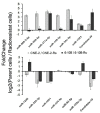Genome-wide analyses of radioresistance-associated miRNA expression profile in nasopharyngeal carcinoma using next generation deep sequencing
- PMID: 24367666
- PMCID: PMC3868612
- DOI: 10.1371/journal.pone.0084486
Genome-wide analyses of radioresistance-associated miRNA expression profile in nasopharyngeal carcinoma using next generation deep sequencing
Erratum in
- PLoS One. 2014;9(10):e110099
Abstract
Background: Rapidly growing evidence suggests that microRNAs (miRNAs) are involved in a wide range of cancer malignant behaviours including radioresistance. Therefore, the present study was designed to investigate miRNA expression patterns associated with radioresistance in NPC.
Methods: The differential expression profiles of miRNAs and mRNAs associated with NPC radioresistance were constructed. The predicted target mRNAs of miRNAs and their enriched signaling pathways were analyzed via biological informatical algorithms. Finally, partial miRNAs and pathways-correlated target mRNAs were validated in two NPC radioreisitant cell models.
Results: 50 known and 9 novel miRNAs with significant difference were identified, and their target mRNAs were narrowed down to 53 nasopharyngeal-/NPC-specific mRNAs. Subsequent KEGG analyses demonstrated that the 53 mRNAs were enriched in 37 signaling pathways. Further qRT-PCR assays confirmed 3 down-regulated miRNAs (miR-324-3p, miR-93-3p and miR-4501), 3 up-regulated miRNAs (miR-371a-5p, miR-34c-5p and miR-1323) and 2 novel miRNAs. Additionally, corresponding alterations of pathways-correlated target mRNAs were observed including 5 up-regulated mRNAs (ICAM1, WNT2B, MYC, HLA-F and TGF-β1) and 3 down-regulated mRNAs (CDH1, PTENP1 and HSP90AA1).
Conclusions: Our study provides an overview of miRNA expression profile and the interactions between miRNA and their target mRNAs, which will deepen our understanding of the important roles of miRNAs in NPC radioresistance.
Conflict of interest statement
Figures





Similar articles
-
Integrated analysis of microRNA regulatory network in nasopharyngeal carcinoma with deep sequencing.J Exp Clin Cancer Res. 2016 Jan 22;35:17. doi: 10.1186/s13046-016-0292-4. J Exp Clin Cancer Res. 2016. PMID: 26795575 Free PMC article.
-
Genome-wide analyses of long noncoding RNA expression profiles correlated with radioresistance in nasopharyngeal carcinoma via next-generation deep sequencing.BMC Cancer. 2016 Sep 6;16(1):719. doi: 10.1186/s12885-016-2755-6. BMC Cancer. 2016. PMID: 27599611 Free PMC article.
-
An in silico analysis of dynamic changes in microRNA expression profiles in stepwise development of nasopharyngeal carcinoma.BMC Med Genomics. 2012 Jan 19;5:3. doi: 10.1186/1755-8794-5-3. BMC Med Genomics. 2012. PMID: 22260379 Free PMC article.
-
miRNA as promising theragnostic biomarkers for predicting radioresistance in cancer: A systematic review and meta-analysis.Crit Rev Oncol Hematol. 2021 Jan;157:103183. doi: 10.1016/j.critrevonc.2020.103183. Epub 2020 Nov 27. Crit Rev Oncol Hematol. 2021. PMID: 33310279
-
MicroRNAs as Therapeutic Targets in Nasopharyngeal Carcinoma.Front Oncol. 2019 Aug 13;9:756. doi: 10.3389/fonc.2019.00756. eCollection 2019. Front Oncol. 2019. PMID: 31456943 Free PMC article. Review.
Cited by
-
Downregulation of SIRT6 by miR-34c-5p is associated with poor prognosis and promotes colon cancer proliferation through inhibiting apoptosis via the JAK2/STAT3 signaling pathway.Int J Oncol. 2018 May;52(5):1515-1527. doi: 10.3892/ijo.2018.4304. Epub 2018 Mar 5. Int J Oncol. 2018. PMID: 29512698 Free PMC article.
-
CircCRIM1 promotes nasopharyngeal carcinoma progression via the miR-34c-5p/FOSL1 axis.Eur J Med Res. 2022 Apr 28;27(1):59. doi: 10.1186/s40001-022-00667-2. Eur J Med Res. 2022. PMID: 35484574 Free PMC article.
-
Small biomarkers with massive impacts: PI3K/AKT/mTOR signalling and microRNA crosstalk regulate nasopharyngeal carcinoma.Biomark Res. 2022 Jul 26;10(1):52. doi: 10.1186/s40364-022-00397-x. Biomark Res. 2022. PMID: 35883139 Free PMC article. Review.
-
USP44 regulates irradiation-induced DNA double-strand break repair and suppresses tumorigenesis in nasopharyngeal carcinoma.Nat Commun. 2022 Jan 25;13(1):501. doi: 10.1038/s41467-022-28158-2. Nat Commun. 2022. PMID: 35079021 Free PMC article.
-
MicroRNA as a Novel Biomarker in the Diagnosis of Head and Neck Cancer.Biomolecules. 2021 Jun 5;11(6):844. doi: 10.3390/biom11060844. Biomolecules. 2021. PMID: 34198889 Free PMC article. Review.
References
Publication types
MeSH terms
Substances
LinkOut - more resources
Full Text Sources
Other Literature Sources
Research Materials
Miscellaneous

